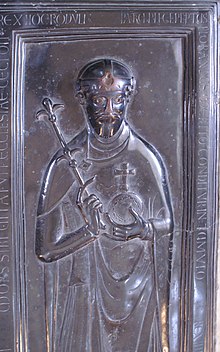Duke Rudolf of Rheinfelden
| Rudolf of Rheinfelden | |
|---|---|
| Duke of Swabia | |

Bronze graveslab, Merseburg Cathedral
|
|
| Born | c. 1025 |
| Died |
15 October 1080 Hohenmölsen, Saxon Eastern March |
| Buried | Merseburg Cathedral |
| Spouse(s) | Matilda of Swabia Adelaide of Savoy |
| Father | Kuno of Rheinfelden |
Rudolf of Rheinfelden (c. 1025 – 15 October 1080) was Duke of Swabia from 1057 to 1079. Initially a follower of his brother-in-law, the Salian emperor Henry IV, his election as German anti-king in 1077 marked the outbreak of the Great Saxon Revolt and the first phase of open conflict in the Investiture Controversy between Emperor and Papacy. After a series of armed conflicts, Rudolf succumbed to his injuries after his forces defeated Henry's in the Battle on the Elster.
Rudolf was the son of the Swabian count (Graf) Kuno of Rheinfelden. He was first mentioned in a 1048 deed issued by the Salian emperor Henry III as a count in the Swabian Sisgau on the High Rhine (in present-day Northwestern Switzerland), an estate then held by the Prince-Bishopric of Basel. Rudolf's family had large possessions up to Sankt Blasien Abbey in the Black Forest and down to the Aargau beyond the border with the Kingdom of Burgundy. He probably was related to King Rudolph II of Burgundy (d. 937), the Dukes of Lorraine and the Ottonian dynasty.
...
Wikipedia
